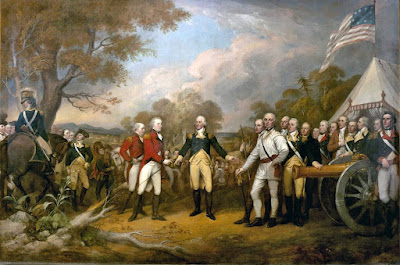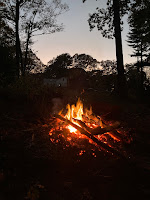On October 18, 1777, over 6,000 men, women and children set out on a march from Stillwater, New York to Boston, Massachusetts - and never made it!
These were the British and German troops of Lieutenant-General John Burgoyne, some accompanied by their wives and children, unsuccessful in their attempt to take control of the Lake Champlain and Hudson River Valleys. Guarding them were citizen-soldiers from American militia units, who together with Continental Army forces under the command of Major-General Horatio Gates, stopped an invasion in its tracks, and in doing so changed the course of history.
A day earlier Burgoyne had offered his sword to Gates in a gesture of surrender to the victorious American army, as pictured in the painting
"The Surrender of General Burgoyne" by artist and Revolutionary War veteran John Trumbull (accessed through the website of
The Architect of the Capitol).
Burgoyne's troops marched
"... out of their camp with the honours of war, ... to the verge of the river where the old fort stood, where the arms and artillery are to be left; the arms to be piled by word of command from their own officers" under the terms of the
Articles of Convention signed by their commander, bound for the port of Boston. [1]
Guaranteed "free passage", ahead of them lay two converging routes over 175 miles long, through towns and villages in New York, Vermont and Massachusetts for the British column, and New York and Massachusetts for their German allies. "We were marched..." wrote Corporal Roger Lamb of the British 9th Regiment of Foot, "... during the rigors of winter, in a cold climate, two hundred miles from Saratoga to Boston... From the outset of the marching we experienced much hardship, sleeping in barns, and having but bad clothing and scanty provisions..." [2]
Their journey didn't end in mystery, but the records of their 1777 march are scattered and few. Their expectation that soon they would board transport ships in Boston Harbor and return to England would be unfulfilled.
Some would spend over five years in captivity before their release, and march again from Massachusetts to Virginia, then Maryland, and Pennsylvania.
For others, there would be parole or escape and a return to service in the British army, a new life in a new country, or an untimely death.
For the United States, the surrender at Saratoga would be a turning point leading to direct French intervention and a successful conclusion of the war in 1783.
For decades I've enjoyed learning about history, traveling to historic sites, and sharing what I've learned. Over the years that interest has taken me from Canada to Georgia to visit the battlefields of the American Revolution and to participate in countless reenactments. It's also taken me to museums, libraries, archives and bookstores to further my knowledge of the events.
Now I've come to better appreciate that history happens just down the street from all of us. For several years now I have been aware that what has become known as the "Convention Army" passed through many central Massachusetts towns, including my own.
This fall, outside in my backyard walking distance from the march route, I was inspired by a late October fire to learn more about who they were, where they stayed and what they experienced. This blog is my way of sharing what I find, and the stories of the people, places and events of those twenty-one days in 1777.
Join me as we connect the dots of their first march. We'll begin with a summary of the Saratoga campaign, the Articles of Convention and an overview of the routes taken. While our primary focus will be their journey, we'll reserve the right to stray from the line of march to examine related topics, both past and present.
[1] Articles of Convention, Article I.
[2] Lamb, Corporal Roger, Memoir of His Own Life, pp. 207, 212.





Comments
Post a Comment